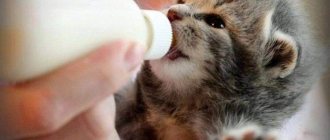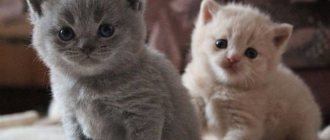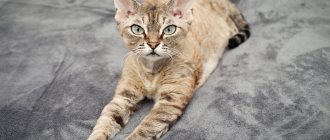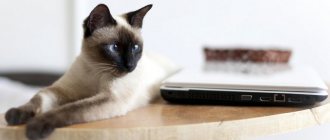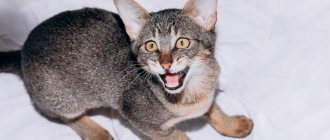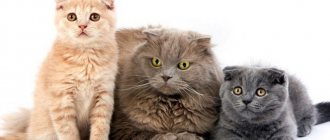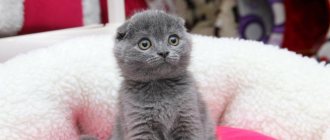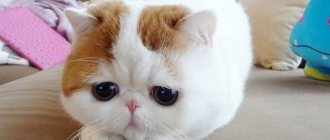The peculiarity of the Scottish Fold cat lies in the shape of its ears, which is not characteristic of other cats; it was once considered a defect, greatly transformed the animal and became the impetus for the creation of a new breed. It was formed with the participation of British and American Shorthair cats.
Not all world organizations enthusiastically accepted the breed with such non-standard ears. Only the CFA and WCF recognized Scottish Fold cats as a test breed in 1974, and four years later, at an elite exhibition in the USA, animals of this breed were met with rave reviews from felinologists and ordinary spectators. Since then, these charming cats began to fully participate in various types of exhibitions.
Breed varieties:
- Scottish Straights have a short coat and straight ears;
- Scottish Fold - short-haired with drooping ears;
- Highland Folds have long fur and ears close to the head.
- Highland Straights are long-haired with straight ears.
In addition to their unusual appearance, Scottish cats also have behavioral characteristics. They love to stand in a column on their hind legs. This is done not to attract attention or to see something better, but to warm up the spine. Another feature is their fear of heights, so they definitely won’t climb on cabinets or hang on curtains; these cats choose more aristocratic methods for their entertainment.
[advertising]
Description of breed standards:
- the body is of medium size, well-developed muscles, the maximum weight of a female is 4-5 kg, a male is 8-10 kg;
- the neck is short and strong;
- the legs are massive, the paws are oval-shaped;
- the tail is short and wide, tapering towards the tip;
- the head is spherical in shape with large plump cheeks, a massive chin and a flattened, humped nose;
- the ears are small, adjacent to the head, rounded at the ends;
- the eyes are large and set wide apart;
- The fur is thick and plush.
Kittens are born with straight ears. Only when they reach the age of 4-5 months can they change their shape and lie on their heads. The shape of their pressing to the head can also be different. Single, double or even triple folding of the ears stands out. The most valuable and expensive of all is the Scottish Fold cat, which has a triple fold of ears that fit snugly to the head, following its contour. Kittens whose ears have not drooped by the time they reach a certain age remain with straight ears for the rest of their lives. The pattern of this process has not yet been clarified, so the number of Scottish Folds in a litter is unpredictable.
Origin story
The history of the Scottish Fold breed began in the mid-20th century in Scotland. On one of the farms, the cat Susie was born: the tips of her ears were curved not up, but down, which gave her face a surprised and funny expression. Susie herself had children like this from time to time. And, quite possibly, they would have remained to live and die on the farm if they had not accidentally caught the eye of a British cat breeder in 1963.
Mary Ross (that was the name of the breeder) immediately realized that this was not just a physical defect, and began to work on a new breed. As a result of mating with a British blue cat and a British shorthair kitten, kittens were born - the first representatives of the Scottish Fold.
A specific gene is responsible for lop ears - Fd. If it is present in both parents, their offspring will face serious problems with the musculoskeletal system and early death. But experimentally it turned out that mating with a Scottish Shorthair - Scottish Straight - allows you to have kittens with desirable external characteristics, but without serious health pathologies.
The Scottish Fold breed was registered in 1994.
Is the Scottish Fold a friendly breed?
Scottish Folds are considered one of the most human-friendly breeds. A high level of intelligence and intuition help them choose the right tactics of behavior. They are not intrusive, but if the owner is in the mood, they will come up to caress. Scottish Folds know funny poses that make many people smile: standing on their hind legs or sleeping on their back with their paws outstretched.
The Scottish Fold can quickly adapt to any number of people. He feels free in the presence of guests, at an exhibition, and at a veterinarian’s appointment.
Standards
There are 2 standards: European and American. They are almost the same, the only difference is that European Scottish Folds have a more massive skeleton and ears that do not fit so tightly to the skull.
| Standard | Description |
| Head | Round, with a massive chin and plump rounded cheeks. The forehead is high, level, the nose is short and fairly wide. |
| Ears | Small, widely spaced. Their tips are rounded, and the ears themselves bend forward and down. At the same time, the standard requires that the ears do not extend beyond the contour of the head. |
| Eyes | Large, round. The iris should be in harmony with the color of the coat. |
| Torso | Strongly built, with pronounced muscles and a well-developed chest. The neck is dense and short. |
| Limbs | Medium length, paws small, round. |
| Tail | Wide at the base, tapering towards the tip. |
| Wool | The coat is thick and elastic. Since it does not fit tightly to the body, it is fluffy in appearance. |
Loop ears are conventionally divided into 3 groups: single (when only the tips of the ears are bent), double (when the auricle is bent, and a gap is visible between the head and ears) and triple (the ears are pressed so tightly to the skull that one gets the impression of their complete absence).
How to cope with loneliness
The little Scottish Fold constantly needs the attention of its owner. He feels safe next to his owner. Left to their own devices, the kittens begin to look for something to do, which results in small domestic pogroms. To prevent this from happening, the kids are occupied with toys and bought treats. House flowers, shoes, wires are hidden or covered.
An adult Scottish Fold may experience loneliness in different ways. Each animal is not devoid of individuality, and the reaction to the same situation can be completely different. One pet can endure loneliness very hard, while another will sleep peacefully all day until the owner arrives.
Weight by month
The average weight of Scottish Folds is 3.5-6 kg (males are larger than females).
| Age | Female (kg) | Male (kg) |
| 1 month | 0.35 — 0.6 | 0.4 — 0.7 |
| 2 | 0.45 — 0.75 | 0.8 — 1.6 |
| 3 | 1.2 — 1.65 | 1.35 — 2.45 |
| 4 | 1.7 — 2.3 | 2.1 — 3.8 |
| 5 | 2.2 — 3.2 | 2.4 — 4.2 |
| 6 | 2.3 — 3.6 | 2.9 — 5.56 |
| 8 | 2.8 — 4.3 | 3.45 — 6.2 |
| 10 | 3 — 4.64 | 4.2 — 7.2 |
| 12 | 3.2 — 5.4 | 4.6 — 7.4 |
| 24 | 3.44 — 5.6 | 5.4 — 8.2 |
Playfulness
The Scottish Fold cannot be called a hyperactive breed, although young kittens are very playful. By nature they are excellent hunters. Hunting is the main activity for animals living in the wild. Games that simulate a chase help the Scottish Fold to maintain physical fitness and spur the instinct of a wild animal.
Movement and play are essential components of the physical and emotional health of the Scottish Fold. In addition, the game for a kitten is a method of studying the world around us and those who live in it.
Colors
There are no strict requirements for color. But at competitions special attention is always paid to harmony, namely: does the color of the eyes and nose match the main color or not? If yes, the animal will receive additional points. Blue or golden eyes with a pink nose and white coat are valued, as well as golden eyes and black paw pads with a jet-black coat.
In the photo there are cats of the Scottish Fold breed (Scottish Fold) of popular colors
Tortoiseshells (torties)
The tortoiseshell color of Scottish Folds is usually tri-colored. Red, white, and black spots are located on a cream or red dominant background. When the genes of the parents are combined in a tortoiseshell kitten, these markings can take on chocolate, blue and cream shades.
When assessing tortoiseshell cats, felinologists pay attention to the even distribution of markings and the intensity of their tone. Fold-eared and straight-eared Scots with a tortoiseshell color are divided into subspecies (depending on the color scheme of the spots).
Black-red
There are black and red-red patterns all over the cat's body. The sizes and shapes of the spots are very diverse. This color is often called tortie.
Chocolate red
The patterns on the wool are brown and red. They stand out against a lighter background and look very interesting. The chocolate red color is considered rare and prized by breeders.
Blue-cream
The tortoiseshell blue-cream color in Scottish pets is determined when the main gray-blue background is covered here and there with small light cream spots.
Important: tortoiseshell coloring is characteristic only of cats. The calico cat is very rare. The appearance of a male tortoiseshell kitten indicates genetic problems. Most likely, an adult pet will not be able to have offspring, since the reproductive functions of its body are impaired.
Character and behavior
Scottish Folds are calm and peaceful phlegmatic people who value their own peace most of all. Very sensitive, vulnerable and affectionate, these cats do not tolerate a change of place of residence, not to mention the owner. Even a simple rearrangement of the room can seriously disturb them.
Scottish Folds are homebody animals who passionately love their bed and daily routine, and all those people who are next to them. They should not be left alone even for a short period of time.
Your 9 to 5 job may make them jealous and sad, so it would be better to get this breed if there is someone at home all the time.
They are patient and affectionate. They don’t like to sit in their arms, but they will never refuse to be stroked. They never enter into direct conflict, but they will be able to stand up for themselves. They will simply ignore a rude person, and they will punch a brawler in the nose.
If a Scottish Fold grew up with a cat of a different breed since childhood, there will be no problems. Even if a strong friendship does not develop between them, they will maintain neutrality. But adult cats should be introduced carefully and gradually. We warn you right away: in half the cases they will not get along. The gentle nature of the Scottish Fold extends exclusively to people, and other animals are perceived by them as rivals. And jealousy plays an important role.
They are not talkative and prefer to remain silent. The Scottish Fold has a thin voice, and the sounds it makes are more like a squeak than the usual meow.
Kittens and teenagers are very playful and are ready to run and jump at any time of the day. Adults treat such fun with disdain.
These are clean and tidy cats that don’t leave a mess behind and know how to take care of themselves.
Once you have chosen a kitten, do not take it away from its mother when it is very young. 11-13 weeks is the optimal age at which it will be easier for the baby to separate from the mother; in addition, by this age the mother will have already taught him to use the tray and eat on his own. And the first vaccinations will already be given. When buying a kitten at the poultry market, you risk purchasing an animal with serious health problems, so you should go to a breeding nursery or a professional breeder to buy it. Choose an active kitten who is not afraid of human hands and voices. He should have clean and dry eyes and butt. It will be ideal if you can observe the behavior of his parents.
Name for a Scottish Fold cat
The nickname for a cat of this breed should be selected in accordance with its character and appearance. It should highlight all the charm of the pet. It is advisable to keep the name short and clear so that the kitten can easily remember it.
Nicknames for females:
- Ariel,
- Barbara,
- Betty,
- Bead,
- Varvara,
- Greta,
- Jesse,
- Juliet,
- Zara,
- Ingrid,
- Coco,
- Cleopatra,
- Margot,
- Nyusha,
- Cecil,
- Trinity,
- Flossie,
- Helga,
- Yasmina.
Nicknames for males:
- Archie,
- Brand,
- William,
- Smoke,
- Zeus,
- Lucky,
- Oscar,
- Pirate,
- Plato,
- Richard,
- Novel,
- William,
- Caesar,
- Charlie,
- Charles,
- Elf,
- Eugene,
- Yasha.
How much does a Scottish cat cost:
- The price in Russia ranges from 5,000 to 15,000 rubles;
- Price in Ukraine – from 1000 to 6000 hryvnia.
It is better to buy pets of this breed in a professional nursery, where the kitten will have good pedigree and health. Also, along with the kitten, documents and detailed care recommendations are inherited. Kittens are delivered from the nursery at the age of two months, already accustomed to the tray and scratching post.
Care instructions
Thick fur requires regular brushing: once a week or 3 times a week (during shedding). It is enough to buy a regular brush: with natural hard bristles. Since animals swallow fur when licking themselves, you need to help them remove it. To do this, you can grow special grass (sold in pet stores) or give a paste for lumps in the stomach.
Bathing
Scottish Folds usually do not mind bathing. You should not bathe your cat more than once every 2-3 months, so as not to wash off the protective layer from the skin once again. But this must be done before the exhibition. Use special cat shampoo: it will not cause an allergic reaction and will not poison your pet.
Does your cat like to swim?
Not really
Ears
Ears are examined and cleaned once a week. Due to the specific structure of the auricle, wax and dirt quickly accumulate there, so you cannot do without a special cleaning lotion. It can be purchased at a veterinary pharmacy.
Do not put liquid or ointment into your ears without your doctor's permission. This provokes otitis media!
Claws
If your Scottish Fold grinds its claws down on its own, all you need to do is buy a quality scratching post. Otherwise, you will have to trim your cat's claws weekly using a nail clipper or regular nail scissors. Be careful not to touch large vessels.
Teeth
Teeth are brushed once every 2 weeks using cat toothpaste and a small toothbrush (you can adapt a regular baby brush by shortening its bristles).
A Scottish Fold kitten costs from 15 to 60 thousand rubles. The price depends on the class (pet, breed, show), appearance.
Life expectancy - how long do Scottish Folds live?
With excellent care, the Scottish Fold can live a long, active life. The average duration is from 15 to 18 years. Since the Scottish Fold is an artificially bred breed, the influence of genes on health, and therefore on life expectancy, is quite large. Unfortunately, the Scottish Fold is characterized by a tendency to a number of genetic pathologies. The kitten receives these diseases of the breed from its parents and earlier ancestors. That's why choosing a future pet should begin with getting to know its father and mother.
A proper lifestyle for the health of the Scottish Fold is extremely important. The pet must exercise enough and eat properly. In addition, injuries and stress should be excluded. If any problems arise, it is important to immediately contact a veterinarian in order to diagnose pathologies at an early stage.
Catering
You can choose to feed your pet: natural food or industrial ready-made food. But it is not recommended to mix one with the other: different enzymes are produced for processing different types of feed, and by complicating the process, you unnecessarily burden the stomach.
Natural products
From natural food you can give:
- Pre-frozen lean meat: veal, beef, turkey, rabbit, lamb, chicken. When cooking, some of the beneficial substances are destroyed, so processing should be minimal. Be sure to pour boiling water over raw meat before serving: this procedure will destroy parasites and their larvae and eggs.
- Fish: trout, hake, salmon, flounder, tuna, navaga. But not more than once a week (excess fish provokes the development of urolithiasis.
- Dairy products: unsalted hard cheese, low-fat cottage cheese, natural yogurt without additives, sour cream, fermented baked milk, yogurt, Varenets.
- Boiled chicken yolk, boiled quail eggs.
- Porridge: rice, millet, buckwheat, oatmeal, pearl barley, semolina. Porridge is cooked in water without sugar, salt or seasonings, adding a little bit of any vegetable oil (half a teaspoon of olive, flaxseed, sunflower).
- Vegetables: broccoli, zucchini, carrots, pumpkin, asparagus, green beans, celery. As a treat: watermelons, melons, cucumbers, apples.
A separate bowl should always contain clean water at a comfortable drinking temperature. Do not feed your cat directly from the tap: tap water is too hard, saturated with salts, bleach and other components dangerous to the animal.
You cannot give:
- fatty, smoked, salty, sweet, sour, spicy, pickled;
- alcohol, compotes, juices, mineral water, tea, coffee;
- dog food;
- human canned food;
- products containing cocoa, seasonings, spices, ketchups;
- eggplant, avocado, onion, garlic, raisins, legumes.
Recommended food
Among ready-made foods, it is better to give preference to holistic foods AATU, Applaws, Canagan, Natural and super-premium Leonardo, Mealfeel, Meowing Heads. Premium and economy class food is made from low quality products, their composition is poor, there are no vitamins and minerals, but there is an abundance of dyes and questionable components.
Below are recommended super-premium foods. Links with the names of the food are clickable, on them you can, within our website, get acquainted with the descriptions of the food and read reviews from owners of Scottish Fold cats.
| Holistic | Super premium | Super premium |
| Acana | Karmy | Landor |
Cost of kittens
Each kitten has an exhibition class, which determines the degree of compliance with the breed standard. This is an important criterion for pricing:
- PET-class are purebred animals whose exterior does not quite meet the standard. PET Scottish Folds are wonderful friends at home. The cost of kittens is from 15 to 20 thousand rubles.
- BREED class - Scottish folds with exterior deviations. They are accepted into the breeding program because they are capable of producing quality SHOW animals. Kittens cost 20-30 thousand rubles.
- SHOW-class – purebred kittens with impeccable pedigree and appearance, born from award-winning sires. Their cost is 30-60 thousand rubles.
- TOP SHOW-class - have the standard qualities of the breed, confirmed by experts. Such kittens are sold at the highest prices - from 60 to 100 thousand rubles. Often, they are left in nurseries for further breeding work.
Scottish Fold kittens without pedigree cost from 4 to 6 thousand rubles. But, in this case, there is a risk of serious genetic abnormalities.
Diseases
Judging by the reviews of owners of Scottish Fold cats, their pets have fairly strong immunity and live a long time (15 years or even more). But the gene responsible for cute ears also gave the animals some unpleasant gifts, namely: problems with the musculoskeletal system. Moreover, these problems appear with age and it is almost impossible to predict whether this will happen or not. A well-designed diet, selection of a good vitamin and mineral supplement, and monitoring the animal’s weight can help as preventive measures.
Due to the structure of the ears, parasites and pathogenic bacteria often get inside. Look into your cat's ear often, and if you suspect something is wrong, take your pet to the veterinarian.
Expert opinion
Dusheba Vera Ivanovna
In 2010, she graduated from the Moscow State Academy of Veterinary Medicine named after K.I. Scriabin with honors, specializing in veterinary medicine. I regularly attend veterinary conferences, congresses, and webinars.
If your Scottish Fold has become unusually lethargic and apathetic, refuses to eat, there is blood in the feces and urine, and there is a stink coming from the mouth, this indicates some kind of disease. Don't put off visiting the veterinary clinic!
Health
Scottish cats live 12–15 years. This breed is in good health. With proper care and nutrition, lops live a long and active life. However, each breed, which was created through genetic mutations, has its own characteristics. There is no need to be alarmed, but it is important to be aware of them.
Joint dysplasia
As we have already said, the result of improper mating of Scottish Folds is genetic diseases, in particular osteochondrodysplasia (OCD), a bone malformation. The gene that is responsible for turning ears also changes the structure of bones and cartilage throughout the body. And if a kitten gets it from both mom and dad, the probability of developing pathology is close to 100%.
Otherwise, the Scottish Fold cat is no different from an ordinary cat. You need to monitor her health, find a good veterinarian who specializes in the health characteristics of Scots and will notice critical changes in time.
Any cat without chronic diseases should see a veterinarian once a year. You can combine the examination with annual vaccination. If necessary, the doctor may order an x-ray if he notices signs of OCD.
As Scottish dogs age, they can develop arthritis in the tail. The painful condition is easy to determine during a routine examination. Be careful and especially attentive with the tails of fold-eared cats.
Problems of brachycephals
Scottish cats are brachycephalic, and the Fold is no exception. This term means that your pet has a short skull. This is why the cat has such a funny flattened face. The width of the animal's head is much greater than its length. This imposes its own characteristics on health. Brachycephalics may have:
- Brachycephalic airway obstruction syndrome. Very narrow nostrils, structural features of the larynx, palate and tongue prevent the free movement of air. If your cat is wheezing, panting, snoring, and coughing, she may have this syndrome. It is treated surgically.
- Entropion of the eyelid (entropion). Breed characteristics contribute to this, and in combination with injury, the risk increases. If the cilia curl inward and touch the eye, they can damage the cornea, so the curl must be corrected through surgery.
- Cataract and glaucoma. Occurs in older cats and is not so common.
- Cardiomyopathy. The propensity of brachycephalics to heart disease forces veterinarians to conduct more thorough examinations before planned operations, such as sterilization.
Brachycephalics have a flattened muzzle, and this can lead to some health problems.
Contrary to misconceptions, folds on the ears do not lead to more serious development of ear diseases and mite damage. Predisposition to deafness is also a myth, although some white cats, as we know, are deaf from birth, but this has nothing to do with the shape of the ears.
Scottish cats are prone to weight gain due to their structure, and the resulting consequences of diabetes and indigestion. We recommend switching your pet to a species-typical food that does not contain useless carbohydrates, giving treats in moderation and giving preference to active games. Every owner can control the weight of their cat.
Photo gallery
Below are photos of cats of the Scottish Fold breed.
Owners' opinion
Owners of Scottish Folds often leave comments about their pets. Most owners speak positively about their favorite plush cats. As a rule, they are balanced, intelligent and beautiful. The Scots are kind to all people and animals. But owners often write about problems associated with this breed. These include high activity of the pet at a young age, disobedience, ignoring family members, damage to furniture and fragile health.
Often, most of the problems that a cat creates are the fault of the owner himself, who did not react in time and did not show the pet how to behave correctly. When it comes to health, you need to carefully monitor the condition of the animal and not leave the situation to chance.
Scottish Folds are the smartest and most graceful creatures that, with proper training and care, will be excellent pets.
Security
- Bowls for water and food, it is recommended to buy ceramic bowls;
- Tray;
- Cat litter; Brushes for hair and teeth;
- Metal combs;
- Massage glove;
- Cosmetics for pets (shampoos, detanglers, etc.);
- Nail clipper;
- Towels;
- Diapers;
- Toys;
- scratching post;
- House.
When a kitten first gets to a new home, it experiences stress. Therefore, it is recommended to lock the kitten in one room with food bowls and a tray, so that he first looks around there (takes a couple of hours), and then begins to explore new territories. At this point, the best time to spend time with the kitten is to play with it. Typically, the adaptation period lasts two to three days.
Similar breeds
- The British Shorthair cat resembles the Scottish Fold in appearance with its round muzzle, tightly knit body, and thick, short, plush-like fur. She is independent, but at the same time, attached to a person. The pet has a phlegmatic disposition, and after reaching maturity it prefers to lead a quiet lifestyle. Unlike the Scots, the British are a natural breed and therefore have excellent health. The British Shorthair was used in the development of the Scottish Fold. In this regard, the breeds are considered related.
- Among cats with unusual ear shapes, American Curls . His ears are not flattened like Scottish ears, but rather turned inside out. The ancestor of curls is considered to be the mongrel cat Shulamith. Her ears, thanks to a mutation, had an unusual shape. The gene that caused the mutation did not affect the general health of the pets, which enabled the breed to actively develop. There are two subspecies of curls with long and short hair. Curls are distinguished by their flexible and sociable disposition. Along with the Scottish, they are considered one of the best positive breeds of domestic cats.
Maintenance cost
Privileged socialization and a comfortable life for the Scottish Fold in the house begin with the preliminary organization of the house and the acquisition of a basic set of cat accessories:
- Bed or house – 2000-3000 rubles.
- Tray - about 1500 rubles.
- Filler (clay or wood is recommended for kittens) – 280 RUR
- Bowls for food and water – 1000 rubles.
- Scratching post – 294 rub.
- Harness and leash for walking – 483 RUR
- Carrying – 660 rub.
- Toys - about 500 rubles.
Total: 11172 rub.
Nutrition
If an industrial diet is chosen, your pet will need four kilograms of dry food per month.
A two-kilogram pack of Natural Greatness “Field&River Recipe” food costs 1,986 rubles.
1986x2= 3964 rub.
When feeding with natural food, you will need about 7 kg of meat or offal worth about 2000 rubles.
Additional products will cost about the same.
2000x2=4000 rub.
Veterinary
The Scottish Fold should be taken to the veterinarian every year to assess its health. In addition, the animal is vaccinated annually with a complex vaccine, dewormed and protected against fleas and ticks.
- Medical examination of a young Scottish Fold on average (external examination, general blood test, selection of diet, recommendations) – 5,000 rubles.
- Vaccination (panleukopenia, rhinotracheitis, calcevirosis, chlamydia) – 1500 rubles.
- Comprehensive protection against helminths, fleas, ticks, ear mites - stronghold drug (drops on the withers) - 450 rubles. (the drug is applied 2 times a year)
Total: 7400 rub.
If Scottish Fold disease occurs, costs will increase significantly.
- Simple operation - from 20,000 rubles.
- Hospital stay – 5500
Total: 36,500 rub. 3 days in hospital + surgery
Grooming
The coat of the Scottish Fold needs to be cared for regularly, so you will have to purchase a small kit in advance for high-quality combing and bathing procedures. In addition, you will need to care for your ears, eyes, teeth, and claws:
- Fuminator FURminator for short-haired cats – RUB 1,976.
- Glove for combing cats – 178 RUR.
- Nail clippers with bottom lock – 193 RUR.
- Hypoallergenic shampoo for cats Elite Organic – 599 RUR.
- “Otokeya” ear lotion, cleansing – 195 RUR.
- Cliny eye lotion – 259 RUR.
Total: 3400 rub.
Exhibitions
The total cost of participation in the Scottish Fold exhibition depends on the size of the entry fee, the class of the event, how many cats will participate in the event, the number of days of presence, and transportation costs. Approximately, the costs of participating in the exhibition will look like this.
- Exhibition fee – 2500 rubles.
- Certificate from a veterinarian – 600 rubles.
- Preparation of the animal - 3000 rubles.
- Exhibition tent – 5000 rub.
- Folding tray, filler, bed, diapers, water, food - 3000-4000 rubles.
- Participation in rings and shows – 500 rubles.
Total: 15,600 rub.
